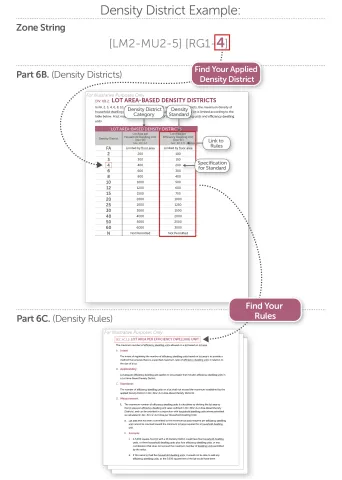Use Finder
Part 6A. Introduction
Div. 6A.1. Orientation
Sec. 6A.1.1. Relationship to Zone String
A zone string is composed of the following districts, as established in Sec. 1.5.2. (Zoning Map):

The Density District is a separate and independent component of each zone.
Sec. 6A.1.2. How to Use Article 6. (Density)
Identify the Applicable Density District
The fifth component in a zone string is the Density District for a property.
Determine Applicable Density District Standards
Density Districts standards are located in Part 6B. (Density Districts). Each Density District identifies the standards specific to that Density District.
Each standard in a Density District in Part 6B. (Density Districts) provides a reference to Part 6C. (Density Rules) where the standard is explained in detail. Text in italics below a heading provides a definition of that heading.

Sec. 6A.1.3. Density District Naming Convention
There are two categories of Density Districts, lot-limited and lot area-based.
Lot-Limited Density Districts
Lot-Limited Density District names include a number, which represents the maximum quantity of household dwelling units allowed on a lot, followed by the letter "L."
Lot Area-Based Density Districts
With the exception of the "FA" and "N" Density Districts, Lot Area-Based Density District names are a number that represents how many hundreds of square feet of lot area are required per household dwelling unit or efficiency dwelling unit. The FA Density District is an abbreviation for "Floor Area," indicating that floor area is the only practical limit to density in this district and that the effective minimum lot area per household dwelling unit or efficiency dwelling unit is zero square feet. The N Density District is an abbreviation for "Not Permitted," indicating that no household dwelling units or efficiency dwelling units are allowed in this Density District.
Div. 6A.2. General Rules
Sec. 6A.2.1. Density
This Article (Density) establishes Density Districts (Part 6B.), a mechanism that regulates the number of household dwelling units or efficiency dwelling units permitted on any lot, otherwise known as density. Density Districts allow for a wide variety of zoning approaches to housing.
Sec. 6A.2.2. Density Applicability
General
All projects filed after the effective date of this Zoning Code (Chapter 1A) shall comply with the density standards in this Article (Density), as further specified in the applicability statement of each Section in Part 6C. (Density Rules). For vested rights, see Sec. 1.4.5. (Vested Rights), and for continuance of existing development, see Sec. 1.4.6. (Continuance of Existing Development).
Nonconformities
Article 12. (Nonconformities) may provide relief from the requirements of this Article (Density) for existing lots, site improvements, buildings and structures, and uses that conformed to the zoning regulations, at the time they were established, but do not conform to current district standards or use permissions. All project activities shall conform with Density District (Part 6B.) standards unless otherwise specified by Div. 12.7. (Nonconforming Density).
Sec. 6A.2.3. Relationship to Use Districts
When household dwelling units or efficiency dwelling units are permitted by a Use District in Part 5B. (Use Districts), the Density Districts in this Article (Density) establish limits on the number of allowed household dwelling units or efficiency dwelling units.
Some Use Districts in Part 5B. (Use Districts) establish additional requirements for household dwelling units and efficiency dwelling units in addition to those in this Article (Density).
Sec. 6A.2.4. Relationship to Public Benefit Systems
Affordable housing incentive programs, outlined in Article 9. (Public Benefit Systems), offer a variety of methods to obtain additional density in excess of the limits established in this Article (Density) and the applied Density District (Part 6B.) in exchange for different affordability levels and types of affordable housing.
Sec. 6A.2.5. Relationship to Form Districts
Form Districts (Part 2B.) do not directly limit density, but do establish requirements that may result in physical constraints that could impact the number of household dwelling units or efficiency dwelling units that can be accommodated on a lot.